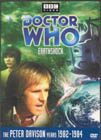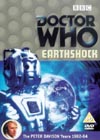DVD Extras include:
The regular characters and the guest characters all get good introductions in this story. Lt. Scott seems to be a futuristic version of the Brigadier, complete with dozens of troops. The regular cast is isolated from the guests for most of the first episode, which doesn't work too badly as the four of them have plenty to work through on their own. The grisly terror that the guests are plodding through is not very enamouring anyway, going for the fright and the gross-out too much for my tastes, although I think it would have been yet more powerful had the Doctor been involved in investigating it. The Doctor has to go through a very boring cliché distrust routine when meeting each set of guest characters, first in the cave and then later on the freighter, but luckily both of these sequences are kept relatively short (unlike some Pertwee tales), and the Doctor has a more logical reason than usual for showing up at the same time as all the problems on the freighter.
"Now, you shall see our STRENGTH!"Much of the strength of this story is in the excellent story beats escalating the plot in the middle episodes. Episode two in particular allows Peter Davison's Doctor to achieve a number of victories against the enemy forces that escalate the plot without revealing to him who his enemies are. The conflict becomes much more direct by episode three. Lots of great stuff - just what you'd want from a good Doctor Who action adventure. Even where it borrows from similar great adventures of the past, writer Eric Saward has a fresh take on things and leaves his own mark.
FIRST IMPRESSIONS - "This Regenerated Form..."Episode Two contains a brilliant sequence that defines the mythological status of the building confrontation in the story, unusually told from the villains' perspective rather than the protagonists. Having relatively little exposure to Doctor Who at the time I first saw this, the sequence of the villains recounting their history with the Doctor instantly elevated them from being simply one of the coolest adversaries of the moment to one of the great long-term foes of the series.This was also the moment when I realized that there had been other Doctors before Tom Baker. Deep stuff to take in. Who were these mysterious stars of the show from times past? I did come away from the sequence with some erroneous assumptions. Jon Pertwee's exclusion from the flashback sequence had me believing mistakenly that Tom Baker was the third Doctor, and that Peter Davison was the fourth. I also assumed that each Doctor got a run of five years.
Solving the Logic Codes...In the final episode, Saward has quite a task to reveal motivations for the characters that make all those previous story beats logical, while keeping the current episode interesting and setting up for his final climactic event. His end result is a fairly well-twisted pretzel that just manages to hold everything together. In terms of providing quality story beats, scene by scene, "Earthshock" is definitely Eric Saward's best original writing on the series.For me, these particular villains have never appeared more powerful in any other Doctor Who story. More frightening maybe, but not more powerful. They do their most serious soldiering of the original show in this adventure, come dangerously close to achieving their most deadly and ambitious plans several times, and always seem to have a contingency plan and the ability to adapt to new scenarios. They have their flaws too, but these are shown to be more flaws of character than anything physical - most notably their arrogance and over-confidence. The philosophical arguments between them and the Doctor are unique highlights in the final episode, played with a nice level of tension by the actors. Of course, with this being the Buyers' Guide review, I'm holding back on much of what I want to say about them and how the story turns out. If you've seen the story or don't care to protect yourself from spoilers, you can find those golden tidbits in the In-Depth Analysis version of this review.
Effects Supporting Story?Dave Chapman achieves some great laser effects in this story, which is no small achievement considering the amount of laser-fire action delivered. Peter Grimwade provides him with less challenging shots than other directors, I think, while giving the viewer a great dramatic ride at the same time. The "candy-stripe" visual beams for the Earth weapons deliver the kind of effect that satisfies me, while the enemy weapons fire, although somewhat inferior, still works quite well in most cases.Neither of these effects are introduced too well though. When the beams debut in the cave, it's impossible to tell who's firing what at whom.... at least not until the third effect shot - the close up of two human troopers with beams initiating from the barrels of their guns. Equally, the enemy weapons effect first seemed to me to represent the human beam weapons bouncing harmlessly off of the enemies, perhaps indicating that they had personal force-field shields or something. It is only much later shots that make it clear what that effect represents. The decision to upgrade several effects for the DVD release seems to be a case of fixing what ain't broke. For one thing, many other stories like "The Pirate Planet" (story no. 99) and "Resurrection of the Daleks" (story no. 134) need laser beam effect upgrades far, far more than "Earthshock" does, and they are sadly not being touched. Secondly, adding motion to the enemies' effect would improve the visual literacy of the story considerably, and is therefore more important than painting over the existing "candy-stripe" beams of the Earth forces. However, when all is said and done, the new beams do look great, very tasteful versions of the old effect that simply look more realistic, closely following the slight motions made by the actors which gave the game away before. The glow from the beams also now reflects off of the surroundings as well. Very cool. The great pity is that the enemies' effects have not been touched. Arrghh! But best of all are all the CGI upgrades of the space exterior shots. Unlike those done for "The Ark in Space" (story no. 76), these shots do a vastly better job of getting the story points across, and making them as dramatic as possible. For one thing, the original version had to make do without some of the shots director Peter Grimwade had planned. The new shots pull out all the stops, and give the ending enough extra punch to make it, for those of us who already know it by heart, as powerful now as it was decades ago when we first saw it. Very well done!
Character FrameThere is less whiney character interaction in this story than in many other Saward works. Most of it is given to Professor Kyle later in the story, which has resulted in widespread disapproval among fans of her character, which otherwise worked very well in the earlier segments of the story. Ringway gets a bit with his crewmates Berger and Captain Briggs, as does Adric in the first episode, but most of these pay off later in the story, making them far more tolerable.Acting is of a high calibre by all participants in the story. It is particularly refreshing to see, in this futuristic setting containing roles normally associated with men, that there is an equal distribution of women in those roles. June Bland and Beryl Reid make the most of this, delivering an utterly believable and enjoyable captain and first officer duo. Peter Grimwade delivers the finest directing in this his last Doctor Who story as director. There is superb coverage and editing, and an infectious, engaging pace. These enemies have never looked better. Excellent!
Concluding action:Eric Saward delivers a number of very satisfying story beats to conclude this story... and yes, I'm only going to discuss that in the In-Depth Analysis version of this review. Let's just say that better temporal logic might have changed the motivations of some of the characters, and leave it at that until you've seen the story.
This story has become available on DVD and VHS video.
Comments on this article are welcome. You may contact the author from this page:
|








